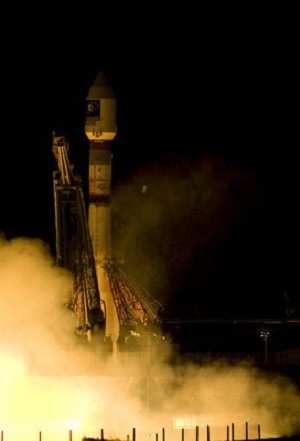GPS Rival Comes Closer To Fruition
 The second test satellite under
Europe's Galileo program launched successfully in the early morning
hours Sunday, giving the European Space Agency a needed boost with
its efforts to establish a satellite navigation system to rival
GPS.
The second test satellite under
Europe's Galileo program launched successfully in the early morning
hours Sunday, giving the European Space Agency a needed boost with
its efforts to establish a satellite navigation system to rival
GPS.
The Galileo In-Orbit Validation Element satellite (GIOVE-B) was
lofted into a medium altitude orbit by a Soyuz/Fregat rocket,
launched from Baikonur cosmodrome in Kazakhstan by launch operator
Starsem. Lift-off occurred at 0416 local time April 27. The Fregat
upper stage safely delivered the satellite into an Equatorial orbit
three hours and 45 minutes later.
"With the successful launch of GIOVE-B, we are about to complete
the demonstration phase for Galileo," said ESA Director General
Jean Jacques Dordain. "The strong cooperation between ESA and the
European Commission has been instrumental in making progress in a
difficult environment over the past few years; and, even with that
being so, Galileo has already materialized, with two satellites now
in orbit, significant headway made on the next four (already in the
construction phase) and a fully qualified EGNOS service -- all this
designed to serve citizens in Europe and all around the globe. ESA
will begin shortly the procurement process for the overall
constellation beyond IOV under EC responsibility."
Like its GIOVE-A predecessor, GIOVE-B carries two redundant
small-size rubidium atomic clocks, each with a stability of 10
nanoseconds per day. It also features an even more accurate
payload: the Passive Hydrogen Maser (PHM), with stability better
than one nanosecond per day. The first of its kind ever to be
launched into space, this is now the most stable clock operating in
earth orbit, according to ESA.
Two PHMs will be used as primary clocks onboard operational
Galileo satellites, with two rubidium clocks serving as back-up.
GIOVE-B also incorporates a radiation-monitoring payload to
characterize the space environment at the altitude of the Galileo
constellation, as well as a laser retroreflector for high-accuracy
laser ranging.
In addition to its technology-demonstration mission, GIOVE-B
will also take over GIOVE-A's mission to secure the Galileo
frequencies, as that first Galileo demonstration satellite launched
in December 2005 is now approaching the end of its operational
life.
Beyond GIOVE-B, the next step in the Galileo program will be the
launch of four operational satellites, to validate the basic
Galileo space and related ground segment, by 2010. Once that
In-Orbit Validation (IOV) phase is completed, the remaining
satellites will be launched and deployed to reach the Full
Operational Capability (FOC), a constellation of 30 identical
satellites.
Galileo will be Europe's very own global navigation satellite
system, providing a highly accurate, guaranteed global positioning
service under civil control. Though designed to be fully
interoperable with the current US Global Positioning System (GPS)
and Russia's GLONASS, ESA intends Galileo to deliver much closer
real-time positioning accuracy.
Numerous applications are planned for Galileo, including
positioning and derived value-added services for transport by road,
rail, air and sea, fisheries and agriculture, oil-prospecting,
civil protection, building, public works and
telecommunications.
 Unfortunate... ANN/SportPlane Resource Guide Adds To Cautionary Advisories
Unfortunate... ANN/SportPlane Resource Guide Adds To Cautionary Advisories ANN FAQ: Turn On Post Notifications
ANN FAQ: Turn On Post Notifications ANN's Daily Aero-Term (04.29.24): Visual Approach Slope Indicator (VASI)
ANN's Daily Aero-Term (04.29.24): Visual Approach Slope Indicator (VASI) ANN's Daily Aero-Term (04.28.24): Airport Marking Aids
ANN's Daily Aero-Term (04.28.24): Airport Marking Aids ANN's Daily Aero-Linx (04.28.24)
ANN's Daily Aero-Linx (04.28.24)



